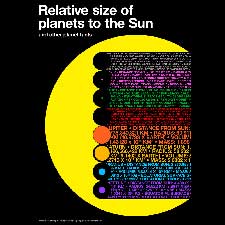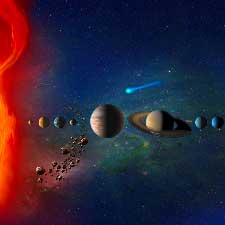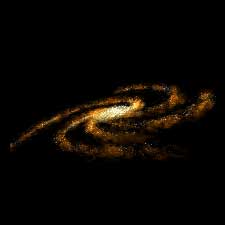The Solar System
Our Solar System comprises of the Sun and all the objects that orbit around the Sun. This includes the 8 known planets which are Mercury, Venus, Earth, Mars, Jupiter, Saturn, Uranus, Neptune and also the 5 known dwarf planets called Ceres, Pluto, Haumea, Makemake and Eris. In addition there are numerous other smaller celestial bodies that make up our Solar System, these include asteroids, comets and moons.
It is believed that our Solar System was formed 4.6 billion years ago. It is not known with absolute certainty have it was formed but scientists believe that it was the result of a gravitational collapse of a huge molecular cloud in space.
The resulting nebula began to spin faster, and increase in heat. A consequence is that it began to flatten into a protoplanetary disc which then began to eject dust and gas which was gravitationally attracted to each other and formed planetary structures. In the early Solar System there may well have been hundreds of planets but over time the merged or were destroyed so that we are now left with our current Solar System consisting of planets and dwarf planets.
Historical views of the Solar System
Our view of the Solar System has change dramatically over time. Originally, the Greek astronomer Ptolemy promoted the idea in around 100BC that the Earth was at the centre of the Solar System and all the planets orbited around the Earth. This was called the geocentric model of the Solar System. The belief that the Earth was at the centre was held for a great many years. It was only until Nicolaus Copernicus (1473-1543) published his work De revolutionibus orbium coelestium libri VI (“Six Books Concerning the Revolutions of the Heavenly Orbs”) in which he proposed that the Sun was in fact the centre of the Solar System and the planets orbited the Sun rather than the Earth that Ptolemy’s earlier work was proved to be incorrect. Copernicus’ heliocentric model of the solar system was later proved correct and has been one of the building blocks for modern astronomical study.
Where is our Solar System in space?
Our Solar System is located in the Orion Arm area of the Milky Way galaxy. Although humankind tend to think of ourselves as the centre of the universe, our Solar System is in fact an insignificantly tiny area in space as a whole.
Consider that the galaxy in which we reside (Milky Way) is believed to be home to 300 billion stars (our Sun is one of those stars included) and we believe that in the observable universe there are 100 billion galaxies, it makes it impossible to comprehend our Solar System’s place in the universe.
The Sun
Central to any discussion about our Solar System is the Sun. It is the object which all other celestial bodies in our solar System orbit around and it contains around 98% of the total mass of our Solar System. It is the dominant force without which there would be no life in our Solar System. Read more about the Sun.
Inner Solar System
The first four planets in our inner Solar System in order are Mercury, Venus, Earth and Mars. These are known as terrestrial planets and are mainly composed of metals and silicate material.
All four planets are dense rocky planets that all have atmospheres which are strong enough to generate weather systems. Of these four planets only the Earth is believed to be capable of supporting life.
Between the final terrestrial planet (Mars) and the first of the gas giants or outer planets (Jupiter) is an area known as the “Asteroid belt”. This is an area which is home to potentially millions of asteroids. Asteroids can range in size between from being dust like to objects that are hundreds of kilometres in diameter and are rocky, icy, metallic objects. It is thought that this belt of asteroids contains the remnants material from the birth of the Solar System. Although there are thought to be a million or more asteroids in this belt, it is not so densely populated that it would cause spacecraft difficulty in navigating (as we have proved to be the case previously with successful flights through the belt). Within the asteroid belt is the dwarf planet Ceres, which was formally known as a large asteroid – it has a diameter of around 1,000 kilometres. In 2006 is was re-classified as a dwarf planet because it was large enough for its own gravity to pull itself into a spherical planet shape.
Outer Solar System
The planets that reside in the outer Solar System are known as the Jovian or gas giant planets. In order from the Sun these planets are Jupiter, Saturn, Uranus, and Neptune. Each of the planets are composed primarily of hydrogen and helium and do not generally have high densities. The gas giant planets are known to have high numbers of moons, over 50 moons in orbit in some cases.
Dwarf planets
There are eight known planets in our solar system. There used to be nine planets but in 2006, Pluto was formally relegated to dwarf planet status. This is because as our astronomical capabilities have increased through better technology we have been able to see further into our solar system and have observed several other objects that rival Pluto in size so it was deemed that we needed to categorise the “major” worlds in our solar system as planets and the smaller outlying worlds as dwarf planets.
Kuiper belt and Oort cloud
Out beyond Pluto you will find an area that is known as the Kuiper belt which is 30 to 50 AU (astronomical units) from the Sun in distance (one astronomical unit is the equivalent to the distance from our Earth to the Sun). It is an area similar to the Asteroid belt, but it is home to objects that are primarily made up of icy materials. It is believed that there could be hundreds more dwarf planets within this region but the current categorised dwarf planets in the Kuiper belt are Pluto, Eris, Makemake and Haumea.
The Oort cloud is an area that is around 50,000 AU away and is thought to be home to up to a trillion ice based objects. It is believed that all long period comets originated from the Oort cloud. We have yet to directly observe this area due to its extreme distance from the Earth, but it is widely accepted amongst astronomers that this theoretical area exists.
Areas further than the Oort cloud are categorised as being on the border of our solar system and there has been no direct observation of this space so until technology advances sufficiently so that we may observe this space we will only be able to postulate what lies therein.


